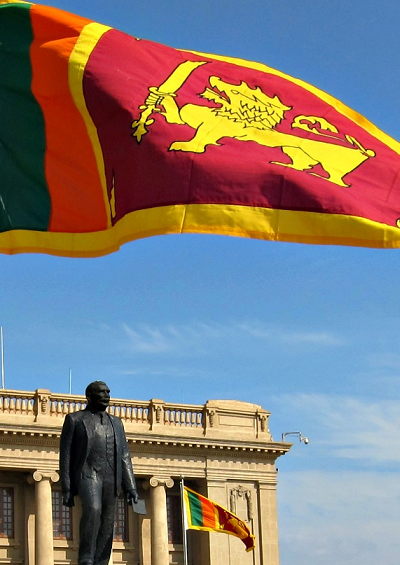The Indo-Pacific Century
Will Sri Lanka be the flagship nation of a new dynamic?

Credit: Ronald Meinardus
President Xi Jinping recently welcomed Prime Minister Ranil Wickremesinghe of Sri Lanka to Beijing. There the two sides worked out agreements of strategic importance.
The move might be startling, as Sri Lanka had planned to reverse its previous dependence on China after a presidential election in January 2015.
Nonetheless, the new coalition – led by President Maithripala Sisisena and Prime Minsiter Wikcremasinghe – apparently have not given up on furthering mutually beneficial Sino-Sri Lankan relations.
To properly understand these changing dynamics, the Sri Lankan government’s new acts must be seen in an “Indo-Pacific” context.
The increasing dependence of China and India on the Indian Ocean have induced these nations to bolster their clout in the region.
The United States, in turn, has to oversee this process with the aim of safeguarding the freedom of navigation.
Why Sri Lanka?
In this precarious situation, Sri Lanka’s geostrategic location, natural endowments and economic gravity make the country an important player. Its actions have overarching repercussions among major powers.
The predominantly Buddhist island nation’s “Middle Path” diplomacy avoids excessive inclination to China, India, or the United States, compelling them to peacefully tolerate each other’s presence in the region.
Following a similar trend, other countries of the Indo-Pacific also simultaneously engage with Beijing, New Delhi and Washington – paving the new road to a “Indo-Pacific” century.
Strategic imperatives
While in Beijing, Wickremesinghe made clear that Colombo is devoted to the “freedom of navigation” in the Indian Ocean.
This commitment is crucial, as this body of water is home to busy commercial waterways, as well as to choke points of global trade such as the Hormuz and Malacca Straits.
As the economies of China and India are reliant on the security of this region, these two countries endeavored to increase their presence in this area.
China initiated its grandiose “One Belt, One Road” (OBOR) initiative, which aims to better integrate Asia, Africa and Europe. It has also recently set out to construct its first overseas naval installation in Djibouti.
Inspired by security grievances related to China’s growing clout in the region, New Delhi has been reluctant to publicly endorse the OBOR and it has adopted an assertive maritime doctrine.
Given that the emergence of China and India creates “an uncertain geometry” in the strategic landscape of the Indian Ocean, the United States is compelled to come to grips with this tendency, in order to maintain the freedom of navigation.
Nevertheless, the prospect of a Sino-U.S.-Indian “tripartite seagoing entente” hangs in the balance as Sino-Indian relations are marred by mutual suspicion and as the Pentagon pushes for a China-inspired “network” defense strategy with Australia, India and Japan.
In all this turmoil, however, Sri Lanka can lead the way to harmonious co-existence in the Indo-Pacific.
Colombo Consensus 2.0
Colombo has a long history of balancing between powerful countries with alacrity.
Nonetheless, Sri Lanka’s previous – and increasingly dictatorial – president, Mahinda Rajapaksa, initiated a foreign policy also known as the “Colombo Consensus.” This consisted of heavy inclination to Beijing and its no-strings attached loans.
During this era, China pushed for large infrastructure projects such as the Hambantota Port, the Colombo Port City and the Lotus Tower.
At the peak of this affinity, President Xi made a historic trip to Sri Lanka and two Chinese navy vessels visited Colombo port in autumn 2014.
The year-2015 marked a turning point in this trajectory. Rajapaksa was ousted from power and the coalition government embarked on the “Colombo Consensus 2.0” – a revised, “Middle Path” foreign policy.
Flagging Sri Lanka-U.S. ties received an adrenaline shot as leading U.S. officials – including Secretary of State John Kerry – and the USS Blue Ridge visited Colombo.
Indo-Lankan bonds also took an amicable turn as Sirisena received Prime Minister Narendra Modi in March 2015. The Indian Oil Company is also moving ahead with development and renovating projects in Trincomalee.
Nevertheless, unlike the Rajapaksa regime, the new administration aims to avoid entirely aligning itself with or distancing itself from any of the strategic players of the Indo-Pacific.
Following a year-long suspension, the Colombo Port City project will continue and China has also set up banking services of the Asian Infrastructure Investment Bank in Sri Lanka. These are clear indicators that Colombo intends to stay within visual range from China.
New autonomy: Independent but interdependent
Apparently, Colombo endeavors to accommodate both China, the United States and India without granting dominance to any of them.
In this way, Sri Lanka urges these giants to learn how to deal with each other, trusting that tension creates innovation for good governance and human progress.
Indeed, China responded creatively with the terrestrial and maritime OBOR strategy to counter President Obama’s Asia Pivot strategy and the Trans-Pacific Partnership (TPP).
Sri Lanka is not a lone example of this tendency among Indo-Pacific players. Australia recently awarded a Chinese company with a 99-year lease deal giving access to the port of Darwin, which is also used by the U.S. Marines.
Additionally, Beijing is a latecomer in Djibouti compared to the Americans, French and Japanese who already have naval facilities there.
Therefore, we see the emergence of a new “Indo-Pacific” World Order. In an effort of adapting to the enduring interests of the United States as well as to the rise of China and India, the countries of the Indo-Pacific do not take sides. Instead, they engage with all of the major powers in order to serve their own interests and people.
Similar to Singapore, Sri Lanka shows us that smaller countries are anything but helpless in great power dynamics.
On the contrary, by compelling great powers to accept each other’s presence, they serve as catalysts in the process of building a harmonious regional order in the Indo-Pacific region.
Editor’s note: The views expressed are entirely the authors’ own and do not necessarily represent the views of affiliated institutions or the U.S. government.



























